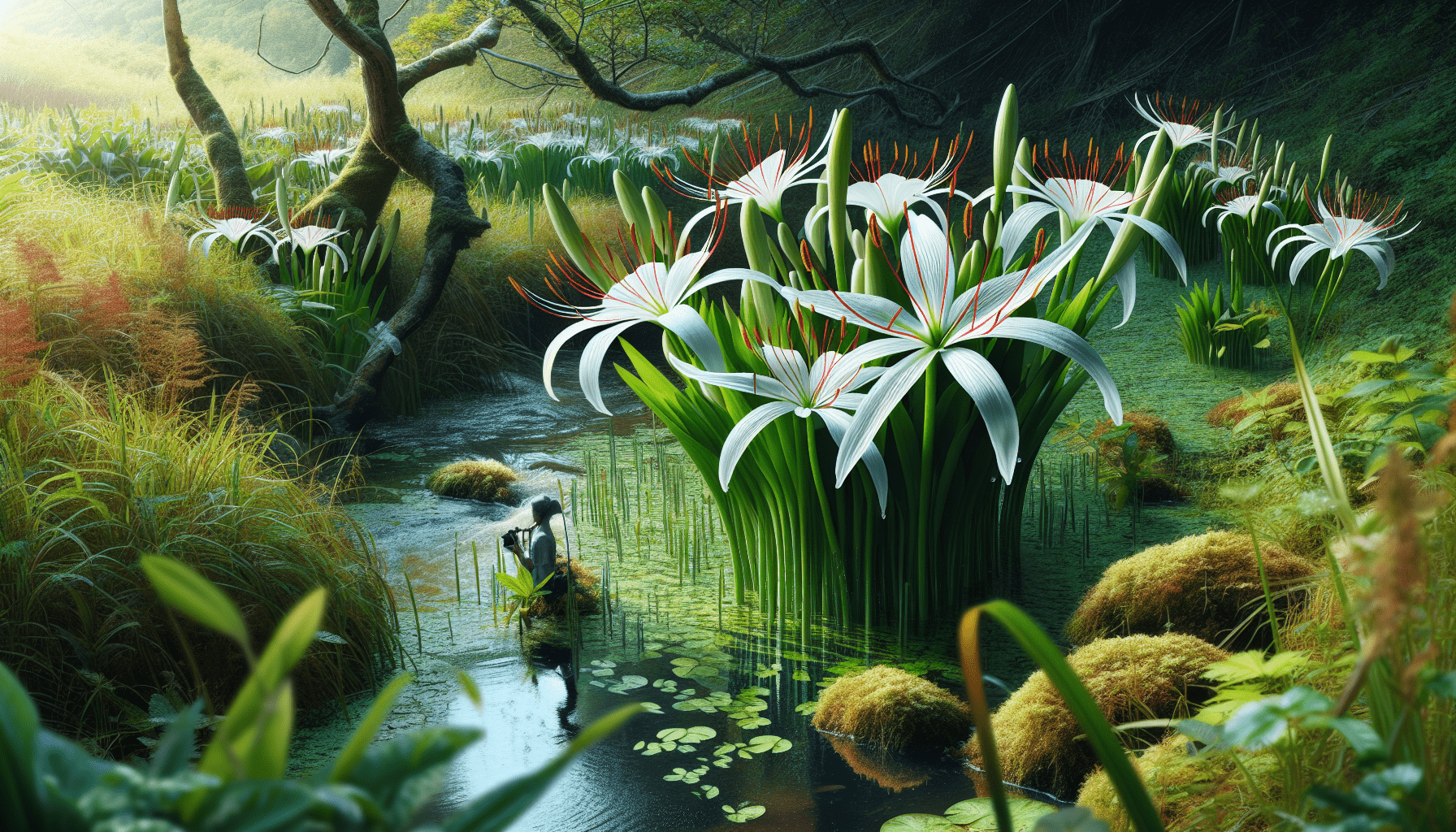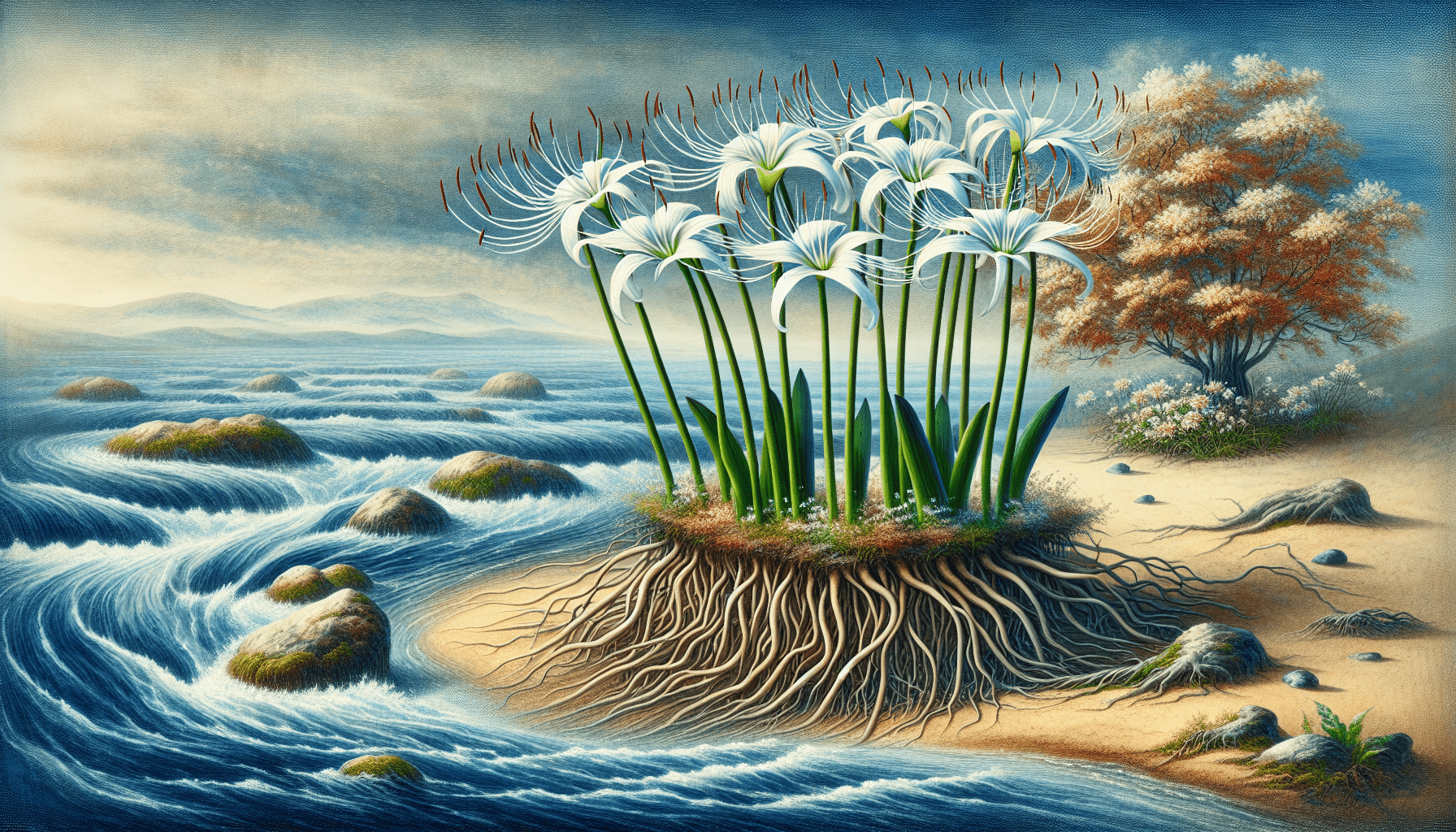In the grand scheme of botanical landscapes, aquatic plants hold a unique, intriguing position. Seemingly transcending the limits of traditional land flora and embracing the hydrosphere, they present a stunning diversity, which ranges from the commonly known water lilies to the less familiar shoal spider lilies. “What Is the Aquatic Plant Shoal Spider Lily” elucidates about this rather lesser-known aquatic plant, shoal spider lily, exploring its various characteristics, its fascinating lifestyle, and its ecological contributions. This provides you a thorough understanding of its place in the rich and complex mosaic of nature’s overall design.

Definition of Shoal Spider Lily
The Shoal Spider Lily, also known as Hymenocallis coronaria, is an aquatic perennial plant species that belongs to the Amaryllis family. This unique lily is characterized by its stunning, spidery petals and its distinctive habitat. The Shoal Spider Lily is one of the many recognized species of spider lilies worldwide, each characterized by distinctive qualities and adaptations suitable to their specific environmental contexts.
Scientific Classification of Shoal Spider Lily
In the scientific classification, the Shoal Spider Lily is a part of the Kingdom Plantae, belonging to the Angiosperms group, which are flowering plants. It is part of the Order Asparagales and falls under the Family Amaryllidaceae. Within this family, it comes under the Genus Hymenocallis and is classified as the species H. coronaria, making its scientific name Hymenocallis coronaria.
Understanding the Term ‘Aquatic Plant’
An aquatic plant, as the name implies, is a plant that has adapted to live in or around aquatic environments. These plants have specific characteristics that enable them to survive in water or in hydric soil. They can be free-floating, submerged, or rooted in the substrate with parts of the plant submerged or floating on the water surface.
Specific Characteristics of Shoal Spider Lily
The Shoal Spider Lily possesses characteristics that allow it to thrive in its unique aquatic environment. It exhibits a robust adaptation to withstand rapid water flow through reinforced, sturdy stems. The plant features long, strap-like leaves and displays delicate, white blooms that resemble the form of a spider, hence its name. Each bloom emits a gentle fragrance and lasts for a few days, attracting a variety of pollinators.
Origins and Habitat of Shoal Spider Lily
Geographical Origins of Shoal Spider Lily
The Shoal Spider Lily is native to the southeastern United States, primarily found along rivers and streams in South Carolina and Georgia. Its existence outside these regions is scarce, making it an endemic species of these areas.
Habitat Requirements and Preferences
Shoal Spider Lily prefers shoal habitats — shallow areas in the middle of rapidly flowing rivers or streams. Here, the plants are exposed to plenty of sunlight, enabling optimal growth and blossoming. They can survive and thrive in sandy or rocky substrates common in the shoals.
Distribution Patterns in the Wild
The distribution of Shoal Spider Lily in the wild is limited, primarily found along numerous rivers across South Carolina and Georgia. The plant forms close-knit colonies in shoals and riverbanks, occasionally migrating downstream due to water currents and seed dispersal mechanisms.
Physical Characteristics of Shoal Spider Lily
Description of the Plant Structure
The Shoal Spider Lily is a robust perennial plant with an erect stem rising up to 3 feet high. The plant blooms from late spring to early summer, presenting delicate white flowers that have a spidery appearance due to the long, thin filaments that extend from the center of the flower. Its strap-like, green leaves can reach up to 3 feet in length, providing an atypical ornamental perspective.
Unique Features and Adaptations to Aquatic Life
The adaptation to aquatic life reveals an intricate play of evolution in the Shoal Spider Lily. The robust structure withstands the force of river currents, preventing the plant from being uprooted. The leaves and flowers are water-repellent, preventing excess water absorption that may lead to rot. Its bulbous roots perform dual roles of anchorage and nutrient storage.
Color and Size Variations
The Shoal Spider Lily remains virtually consistent in terms of color and size. The plant is crowned by its large, white flowers from spring through early summer. Size varies slightly, largely depending on the local conditions and nutrient availability, but typically stands between 2 to 3 feet tall.
Life Cycle and Growth Patterns
Stages of Growth and Development
The Shoal Spider Lily exhibits a typical perennial plant growth pattern. It begins as a seed, grows into a seedling, and eventually develops into a mature plant that blossoms each spring. After the flowering period, the plant focuses on storing nutrients in its bulb for the dormant winter period before starting the cycle anew.
How the Plant Reproduces
The Shoal Spider Lily reproduces sexually through the production of flowers. Each flower, following pollination by several night insects and some birds, produces an abundance of seeds packed into a large, green capsule. Once mature, the capsule splits open, releasing the seeds that are carried downstream by the water currents, where they eventually germinate and form new plants.
Typical Lifespan of the Shoal Spider Lily
As a perennial plant, the Shoal Spider Lily can live for many years, continuing to bloom and produce seeds over various seasons. The exact lifespan, however, varies depending on factors such as environmental conditions, levels of disturbance, and seasonal variations.

Nutrition and Photosynthesis Process
How Shoal Spider Lily Derives Its Nutrients
The Shoal Spider Lily, like all green plants, derives its primary nutrients from the soil using its roots. Nutrients are absorbed from the substrate and stored in the roots, including water, oxygen, and various mineral nutrients such as nitrogen, phosphorus, and potassium, which are essential for plant growth.
Understanding the Photosynthesis Process
Photosynthesis is a vital process in which plants, including the Shoal Spider Lily, convert sunlight, water, and carbon dioxide into glucose and oxygen. This happens primarily in the leaves via photosynthetic cells called chloroplasts, which contain a pigment known as chlorophyll that absorbs sunlight. The plant uses glucose for energy and growth, while oxygen is released back into the environment.
Role of Sunlight and Water in the Plant’s Growth
For the Shoal Spider Lily, sunlight, and water are vital for its survival. Sunlight, as a primary ingredient for photosynthesis, determines the energy source for the plant’s growth. The plant’s habitat ensures a constant water supply which aids in transporting nutrients, generating food and contributing to the plant’s structure.
Cultural Significance and Uses
Historical Uses of Shoal Spider Lily
Historically, the bulbs of Shoal Spider Lily were used by the indigenous tribes for medicinal purposes. The plant was known to have been used for treating ailments such as asthma and heart-related conditions. Despite significant potential, scientific validation of these medicinal uses remains scarce.
Current Uses – Aesthetic, Medicine, etc.
In today’s world, the Shoal Spider Lily is widely appreciated for its aesthetic appeal. Used as an ornamental plant, it brightens gardens and parks during its flowering season. In folk medicine, the plant’s parts are still used in the treatment of various ailments, though scientific verification is necessary.
Its Significance in Different Cultures
The Shoal Spider Lily, while less recognized globally due to its regional confinement, holds a unique place within the local culture of the southeastern United States. It is admired for its beauty, symbolizing purity, and it bestows an enchanting allure to the region during its blooming season.
Threats and Conservation Status
Known Threats to Shoal Spider Lily Populations
The Shoal Spider Lily is facing a decline in its native habitats due to human-induced factors. Dam construction, water pollution, and habitat destruction pose significant threats to this aquatic plant. Changes in water flow due to these factors significantly impact the plant’s distribution and growth, threatening its survival in the wild.
Conservation Status According to Various Environmental Bodies
The Shoal Spider Lily is currently listed as “Endangered” in various environmental bodies, including the U.S. Federal List. Its vulnerable habitat, confined distribution, and human-induced threats make it a concern for many conservation initiatives.
Efforts Being Made to Protect and Preserve the Species
Efforts are being made on several levels to protect and conserve the Shoal Spider Lily. Conservation initiatives such as inhibiting the destruction of their shoal habitats, monitoring populations, promoting public awareness, and ex-situ cultivation in gardens and parks are in place to protect this unique species.
Maintenance and Cultivation in Gardens and Parks
Requirements for Cultivating Shoal Spider Lily
Cultivating the Shoal Spider Lily requires recreating its natural conditions. It requires well-draining soil, full sun, and copious amounts of water. Large pebbles can be added for structural support to mimic its native shoal habitat. Moreover, it can also be grown in containers submerged in water.
Steps to Maintain and Promote Growth
Maintaining the Shoal Spider Lily involves providing sufficient sunlight and water, added nutrients, and regular check-ups for pests or diseases. Pruning is not necessary, as the plant is a robust grower. Observing the plant’s growth, adjusting light, water, and substrates can help promote a healthy, blossoming Shoal Spider Lily.
Handling of Common Pests and Diseases
Even though the Shoal Spider Lily is relatively resistant to common pests and diseases, it may occasionally suffer from bulb rot or be affected by pests like aphids. Care should be taken to observe leaves, petals, and bulb health regularly. In the case of any abnormalities, a suitable treatment should be administered promptly.
Ecological Role and Interactions
Role in its Ecosystem and Interactions with Other Species
The Shoal Spider Lily plays a crucial role in its ecosystem. Its flowers provide nectar for bees and other insects, aiding in their pollination endeavors. The plant’s robust structure prevents erosion in the shoal habitats. It also provides a suitable microhabitat for several smaller aquatic and terrestrial organisms.
Contribution to Biodiversity
The Shoal Spider Lily adds to the biodiversity of its native habitat—being a distinctive part of the flora in the southeastern United States central river ecosystem and contributing significantly to its unique biodiversity.
Impacts of its Absence from its Natural Ecosystem
The decline or absence of the Shoal Spider Lily would translate to a loss of biodiversity, affecting the ecological dynamics of the river ecosystems where it thrives. Any probable decline could impact local wildlife and human communities culturally and environmentally.
Research and Studies on Shoal Spider Lily
Current Research Findings and Ongoing Studies
Current research aims at understanding the population dynamics and threat assessments of the Shoal Spider Lily. Studies have revealed specific adaptations that cater to the plant’s aquatic life. The studies on its chemical components and medicinal applications are limited but hold promising prospects.
Historical Research and Breakthrough Findings
Historical research on the Shoal Spider Lily has focused on its distribution, habitat preference, and basic biological understanding. The adaptational specializations for an aquatic life, and the record of its medicinal use by the local tribes, stand as breakthroughs in understanding this unique species.
Potential Areas of Future Research
The need for the hour is to conduct more rigorous research on the conservation efforts of the Shoal Spider Lily. Other potential areas include understanding genetic diversity, potential cultivation and propagation techniques, and in-depth exploration of medicinal properties. Exploring the plant’s ecological roles and interactions are also areas worthy of magnified research focus.
